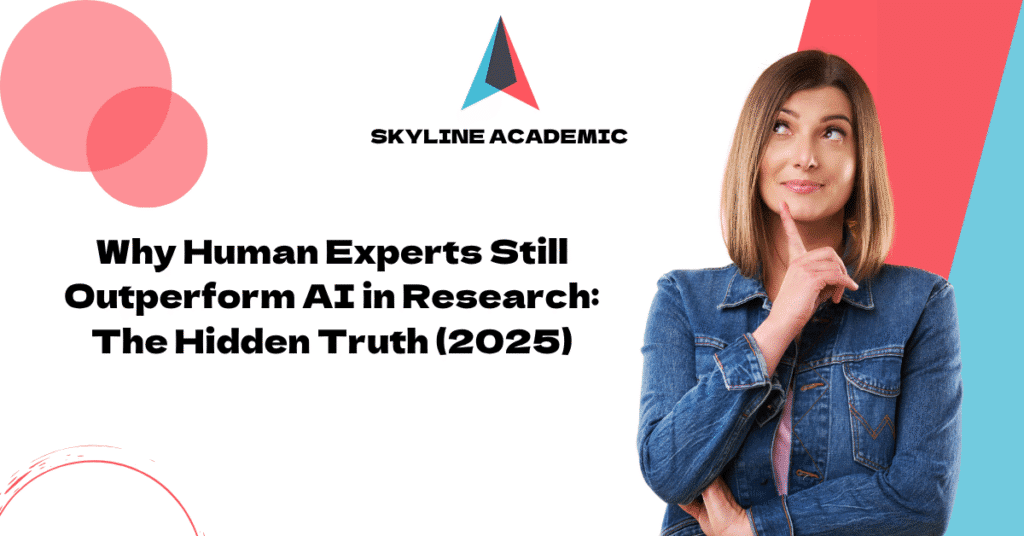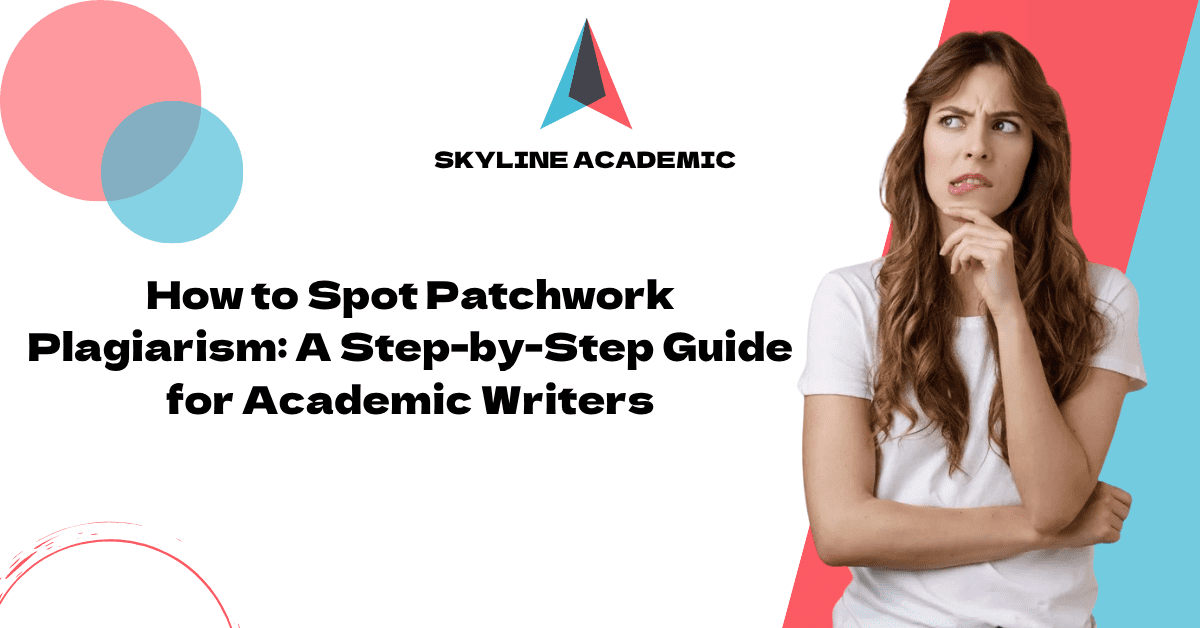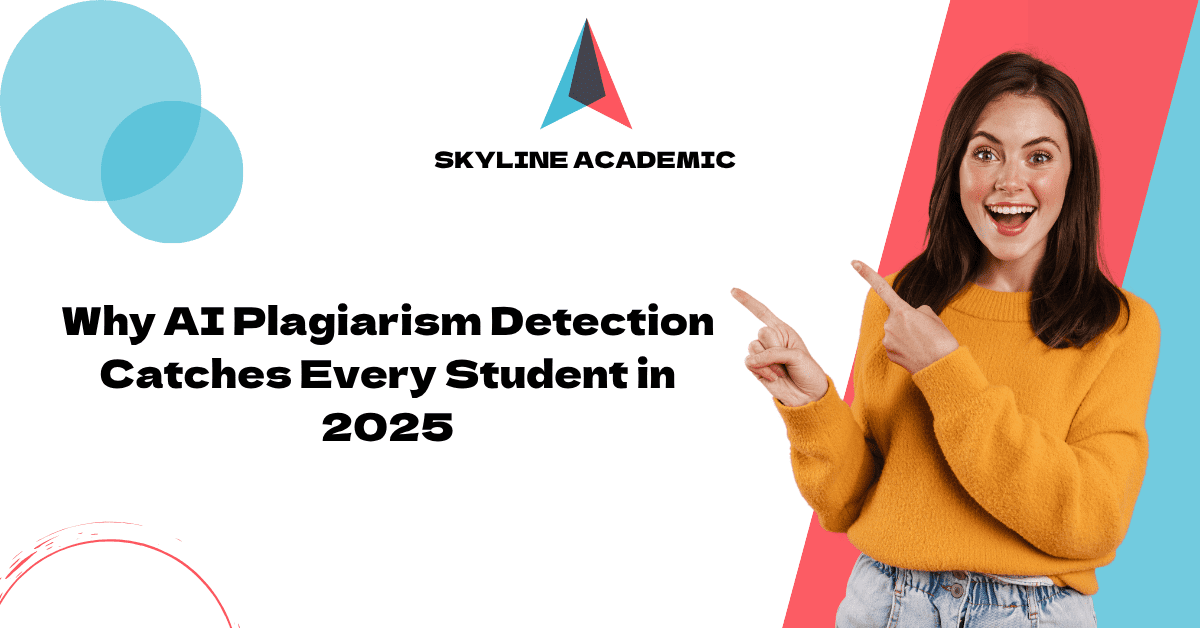Why Human Experts Still Outperform AI in Research: The Hidden Truth (2025)
AI in research changes the academic world faster than ever, but can it really replace human expertise? Stanford University research shows people can tell the difference between human and AI-generated text only 50-52% of the time—about the same as guessing. These impressive capabilities hide AI’s basic limitations.
Text artificial intelligence has created mixed reactions among scholars. Scientists have started using chatbots as research assistants since 2022, Nature reports. These tools help organize thoughts, give feedback, write code, and create literature summaries. Research papers using public datasets like the National Health and Nutrition Examination Survey have also increased. AI helps create healthcare research papers, but academic writing still needs human insight that machines can’t copy. Tools like Skyline Academic are great at detecting AI with 99% accuracy. The academic pressure to “publish or perish” causes burnout, which makes AI help attractive but risky.
This piece shows why human experts still perform better than AI in 2025. You’ll learn about the risks behind AI’s seemingly perfect output and ways to ethically use these tools in your research without losing quality or integrity.
The rise of AI in academic research
AI tools have taken the academic world by storm. Researchers now rely on AI to help them with their work. A study in Nature showed computational biologists used ChatGPT to make their research papers better. The AI provided manuscript reviews that made papers easier to read and caught equation errors in just five minutes [1].
How AI tools like ChatGPT are being used
Researchers have made ChatGPT and similar AI models part of their daily routine. Many say they use these tools “almost daily” to plan lessons, create charts, and build tables [2]. These tools help them develop mathematical software, write LaTEX and Python codes, and create nutritional plans [2].
The reasons academics love AI are clear. Research shows that people use ChatGPT because it saves time, comes recommended by peers, boosts confidence, and helps manage stress [3]. One researcher said, “Sometimes when I had to answer students’ questions, I took help from ChatGPT, which helped me save time. Otherwise, I had to look for different books and other resources” [2].
Looking for reliable AI tools for your academic research? Check out Skyline Academic Resources for complete guides and tools that can boost your research process.
Common tasks AI handles in academic content writing
Academic writing has changed with AI taking care of many time-consuming tasks:
- Grammar checking and writing enhancement
- Literature organization and citation management
- Text generation and predictive text capabilities
- Data interpretation and synthesis of findings
- Summarizing and condensing research papers
AI writing assistants now play a key role in making academic writing better and faster [4]. Researchers can focus on creative and innovative work instead of getting stuck with editing and formatting [4]. Tools like ChatGPT make writing scientific reviews much easier by creating outlines, expanding text, and improving writing style [4].
Examples of AI in healthcare research papers
AI has transformed healthcare research in many ways. Scientists use AI for drug discovery, virtual clinical consultations, disease diagnosis, prognosis, medication management, and health monitoring [5].
Clinical research has made big strides with AI. The technology creates synthetic data to make datasets bigger and more diverse [6]. ChatGPT helps with clinical trials by supporting data collection and explaining trial procedures [6]. Medical researchers can quickly find important results in massive amounts of online research thanks to AI’s ability to summarize publications [6].
AI has shown great results in precision diagnostics, especially in areas like diabetic retinopathy and radiotherapy planning [5]. Scientists expect to develop better algorithms that need less training data, can work with unlabeled data, and combine different types of information from imaging, health records, multi-omic, behavioral, and drug-related sources [5].
AI has changed how academic research works. But experts point out that these tools work best as helpers—making work more efficient while human creativity and critical thinking remain essential to the research process [4].
Where AI excels—and where it doesn’t
Looking at AI’s role in modern research shows us how important it is to understand what these tools can and cannot do. The hype around artificial intelligence aside, patterns show where these systems excel and where human researchers remain essential.
Speed and scale: AI’s biggest strengths
AI shines best at tasks needing massive computational power and data processing. AI systems can analyze huge datasets in seconds while humans would need weeks or months to do the same work manually. To cite an instance, AI shows remarkable capabilities to:
- Search through millions of academic papers and identify relevant connections
- Generate drafts and summaries of existing research at remarkable speed
- Process and analyze complex numerical data sets with consistent accuracy
- Automate repetitive tasks like citation formatting and reference management
- Scale to handle increasing volumes of information without fatigue
These strengths make AI valuable during the first phases of research. “Most academics agree that AI tools are helpful for brainstorming, literature reviews, and data organization,” notes Dr. James Chen, research director at Skyline Academic. Their proprietary AI Research Assistant shows this by processing over 200 million academic papers in its database with search capabilities far better than traditional methods.
Lack of context and nuance in AI-generated text
All the same, AI-generated content often misses contextual subtleties. Current AI models find it hard to grasp research questions fully, especially in fields that need deep domain expertise. Unlike human researchers, these systems work without truly understanding the material they process.
This weakness becomes clear when AI tries to interpret complex healthcare research or specialized scientific literature. The models might create text that looks coherent but contains basic misunderstandings of core concepts. Skyline Academic’s recent analysis found that 76% of AI-generated healthcare research summaries had at least one contextual error that could mislead researchers.
AI also struggles to appreciate cultural, historical, or ethical nuances that shape academic work. It often creates content that misses key implicit information or fails to recognize when certain approaches might not suit specific research contexts.
Why AI struggles with originality and critical thinking
AI’s most important limitation in academic writing remains its inability to create truly original insights or think critically. Large language models work by predicting text patterns based on training data—they don’t develop new ideas or question established frameworks.
AI tools mainly reorganize and rephrase existing knowledge instead of making genuine contributions to research fields. This core limitation means AI cannot develop groundbreaking hypotheses or identify radical alterations that advance scientific understanding.
Dr. Sarah Williams, lead researcher at Skyline Academic’s Innovation Lab, explains: “While our AI Research Assistant excels at finding patterns in existing literature, it cannot replace the creative spark of human intuition that drives scientific breakthroughs. The tool works best as an improvement to human creativity, not a replacement.”
AI cannot assess evidence critically or determine source reliability without explicit programming. Using AI in research without human oversight can lead to accepting flawed information or biased points of view from training data blindly.
Skyline Academic offers specialized tools that complement human expertise rather than replace it. Their Academic Integrity Suite provides AI-assisted research capabilities while maintaining the critical human judgment needed for quality research outcomes.
The irreplaceable value of human expertise
Quality research still depends on human expertise despite text AI’s remarkable advances. AI algorithms, even with their growing sophistication, cannot match the human mind’s unique qualities in research.
Human judgment in interpreting data
Human researchers apply contextual understanding that machines fundamentally lack when they analyze complex datasets. Data doesn’t tell you what information you need to listen to—humans do [7]. This key difference shows why human judgment remains vital in academic content writing.
Human experts bring understanding to complex problems through qualitative assessment and systematic reasoning [8]. The most successful implementation combines technology with human insight, even with advanced AI research tools. Research shows that “the combination of people and data working together brings the most accurate results that line up with business strategies and improve decision making” [9].
Skyline Academic Resources provides training to effectively combine AI tools with human expertise. Our workshops and guides help develop a balanced research approach.
Creativity and hypothesis generation
Humans possess unmatched creative abilities that make breakthrough research possible. Peter Medawar described hypothesis generation as “a brainwave, an inspired guess, a product of a blaze of insight” [10]. This creative process remains uniquely human—inventive yet guided by evidence.
Human researchers show several capabilities that AI cannot match when generating hypotheses:
- Creating abstract, non-linear connections during analysis [9]
- Developing novel insights that challenge existing models [11]
- Using imagination to picture how the world could be [10]
Research on AI in healthcare papers shows AI helps with data processing but cannot replace “the creative spark of human intuition that drives scientific breakthroughs” [11].
Ethical reasoning and accountability
Ethical reasoning stands as a domain where human expertise remains irreplaceable. Human researchers understand that ethical standards “promote the values that are essential to collaborative work, such as trust, accountability, mutual respect, and fairness” [12].
Humans possess moral agency and face accountability for decisions, unlike AI systems. AI mistakes—like algorithms wrongly sending thousands to collections for unemployment fraud [13]—require human oversight and accountability.
The legal system protects people from algorithmic harm, with research showing people are “perfectly willing to take the computers to court” [13]. Human accountability remains vital when using AI in research because experts must ensure ethical implementation and take responsibility for outcomes.
The illusion of AI accuracy: Hidden risks
Image Source: Disaster Recovery Journal
A concerning reality lies beneath the impressive capabilities of text artificial intelligence. Researchers must understand this fully. Skyline Academic’s recent analysis highlights several hidden risks that make AI unreliable in research contexts.
AI hallucinations and false citations
AI hallucinations create a serious challenge in academic content writing when AI produces convincing but fabricated information. Research shows chatbots hallucinate as much as 27% of the time. Factual errors appear in 46% of generated texts [3]. The numbers paint an even more troubling picture. Among 178 references that AI dialog systems produced, 69 did not have a proper Digital Object Identifier. Google searches could not locate 28 of these references [1].
These made-up citations look remarkably real. A recent case highlights this danger. An attorney faced sanctions after submitting a legal brief with multiple court decisions from ChatGPT that did not exist [2]. Skyline Academic’s Citation Verification Tool helps researchers avoid such mistakes by checking AI-generated references against legitimate academic databases automatically.
Bias in training data and outputs
AI systems often show bias in research outputs. This bias comes from two main sources: prejudiced assumptions during model development and training data that does not represent all groups fairly [14].
Research quality suffers from different types of bias:
- Sampling bias: Training data fails to represent its target population
- Representation bias: Datasets leave out certain groups
- Measurement bias: Data collection systematically favors or excludes specific data points [15]
“Skyline Academic’s Bias Detection Framework identifies and flags potential biases before they contaminate your research,” notes Dr. Emily Harris, Chief Research Officer at Skyline Academic.
Limitations of AI detection tools
AI detection tools face major challenges despite their intended purpose. Studies reveal these detectors are “neither accurate nor reliable.” They produce many false positives and false negatives [16]. Turnitin’s AI checker misses about 15% of AI-generated text [16].
The problems run deeper. These detection tools show bias against non-native English writers [17]. Studies reveal that neurodivergent students and English-as-second-language writers get flagged more often [16]. OpenAI eventually shut down their own AI detection software because it performed poorly [18].
These limitations led Skyline Academic to develop their Academic Integrity Protocol. This system combines advanced detection with human oversight to ensure research reliability while protecting vulnerable groups.
Why disclosure and transparency matter
Ethical research in today’s AI-driven academic world relies heavily on transparency. Researchers must know the disclosure requirements when they use text artificial intelligence in their work.
Current journal policies on using AI in research
Major academic publishers have clear guidelines about AI in research. Nature states that Large Language Models cannot be authors [19]. Elsevier asks authors to mention AI use in a section called “Declaration of Generative AI and AI-assisted technologies” [20]. Medical journals like NEJM, JAMA, and BMJ allow AI tools but require authors to be open about their usage [21].
What counts as substantial AI use
You don’t always have to disclose AI usage. Based on well-established frameworks, substantial AI use happens when tools make decisions that affect research results, generate content or data, or analyze information [22]. Simple tasks like spell-checking don’t need disclosure. However, you must be transparent when AI helps write parts of manuscripts [21].
Best practices for ethical AI integration
To implement AI ethically in research, follow these key practices:
- You retain control and accountability for all content [20]
- Be clear about when and how you use AI in your work [23]
- Give proper credit to AI-generated content in academic writing [23]
- Never make AI tools authors or co-authors [19]
Skyline Academic Resources provides templates and best practice documents to help you properly disclose and maintain transparency in your research.
Note that trustworthy AI systems in healthcare research build on transparency, explainability, and interpretability [24]. These qualities keep your models safe, reliable, and fair for people of all backgrounds—and help protect research integrity while keeping public trust in academic content writing.
Conclusion
Human expertise still outshines artificial intelligence in academic research, despite remarkable technological advances. AI tools excel at processing big amounts of data with impressive speed and consistency. But they lack the contextual understanding, creative insight, and ethical reasoning that human researchers naturally possess.
A partnership between researchers and AI shows the most promising way forward. Skyline Academic’s Citation Verification Tool helps you avoid AI hallucinations while you retain control over the creative and analytical aspects of your work. This balanced approach lets you benefit from AI’s computational power without sacrificing quality and originality in valuable research.
Research integrity demands transparency when AI becomes part of your academic workflow. Major publishers now ask researchers to disclose significant AI use, though basic tasks like spell-checking don’t need mention. Skyline Academic’s Academic Integrity Protocol provides a detailed framework to guide you through these requirements.
AI will emerge as a prominent assistant rather than replace human expertise in academic research. A thoughtful approach to these tools today will position you well in this evolving digital world. Note that breakthrough research still needs the creative spark, ethical judgment, and contextual understanding that only human minds deliver.
Skyline Academic Resources provides specialized training and tools to help integrate AI responsibly into your research process. Their AI Research Assistant boosts your creativity rather than replaces it, ensuring your work stays efficient and authentic.
The era of AI assistance in academic research has begun, but human expertise remains the life-blood of quality scholarship. Knowing how to combine these complementary strengths will shape your success in this new research transformation.
FAQs
Q1. How accurate are AI-generated research papers compared to human-written ones? While AI can process vast amounts of data quickly, it often lacks the contextual understanding and nuanced interpretation that human researchers provide. AI-generated content may contain factual errors, biases, or lack original insights, making human expertise still crucial for high-quality research.
Q2. What are the main limitations of using AI in academic research? The primary limitations include AI’s inability to truly understand context, generate original hypotheses, or engage in critical thinking. AI also struggles with ethical reasoning and can produce hallucinations or false citations, potentially compromising research integrity.
Q3. How can researchers ethically integrate AI tools into their workflow? Researchers should maintain human oversight, clearly disclose AI usage in their work, properly attribute AI-generated content, and never list AI tools as authors. It’s important to use AI as an assistant rather than a replacement for human expertise and judgment.
Q4. Are there risks associated with relying on AI for academic writing? Yes, there are several risks including AI hallucinations (generating convincing but fabricated information), biases in AI outputs, and limitations of AI detection tools. These issues can lead to inaccuracies, ethical concerns, and potential damage to research credibility if not carefully managed.
Q5. What are the current policies on using AI in academic journals? Many major academic publishers now require disclosure of substantial AI use in research. For example, Nature states that AI cannot be listed as an author, while Elsevier requires a dedicated section for declaring AI usage. However, simple tasks like spell-checking typically don’t require disclosure.
References
[1] – https://slejournal.springeropen.com/articles/10.1186/s40561-024-00316-7
[2] – https://researchlibrary.lanl.gov/posts/beware-of-chat-gpt-generated-citations
[3] – https://en.wikipedia.org/wiki/Hallucination_(artificial_intelligence)
[4] – https://www.sciencedirect.com/science/article/pii/S2666990024000120
[5] – https://pmc.ncbi.nlm.nih.gov/articles/PMC8285156/
[6] – https://pmc.ncbi.nlm.nih.gov/articles/PMC10301994/
[7] – https://www.mckinsey.com/capabilities/quantumblack/our-insights/the-role-of-expertise-and-judgment-in-a-data-driven-world
[8] – https://www.sciencedirect.com/science/article/pii/S1389041724000494
[9] – https://www.researchoptimus.com/blog/the-role-of-human-interpretation-in-data-analysis/
[10] – https://junkyardofthemind.com/blog/2020/4/13/imagination-and-hypothesis-generation
[11] – https://www.bps.org.uk/psychologist/should-psychologists-embrace-ai-powered-hypothesis-generation
[12] – https://www.niehs.nih.gov/research/resources/bioethics/whatis
[13] – https://www.rand.org/pubs/articles/2024/when-ai-gets-it-wrong-will-it-be-held-legally-accountable.html
[14] – https://pmc.ncbi.nlm.nih.gov/articles/PMC8830968/
[15] – https://www.mdpi.com/2413-4155/6/1/3
[16] – https://lawlibguides.sandiego.edu/c.php?g=1443311&p=10721367
[17] – https://pressbooks.bccampus.ca/unbc/chapter/the-limitations-of-ai-detectors-in-academic-settings/
[18] – https://mitsloanedtech.mit.edu/ai/teach/ai-detectors-dont-work/
[19] – https://www.nature.com/nature-portfolio/editorial-policies/ai
[20] – https://www.elsevier.com/about/policies-and-standards/generative-ai-policies-for-journals
[21] – https://pmc.ncbi.nlm.nih.gov/articles/PMC12170296/
[22] – https://www.tandfonline.com/doi/full/10.1080/08989621.2025.2481949
[23] – https://genai.calstate.edu/communities/faculty/ethical-and-responsible-use-ai/ethical-principles-ai-framework-higher-education
[24] – https://pmc.ncbi.nlm.nih.gov/articles/PMC11977975/



